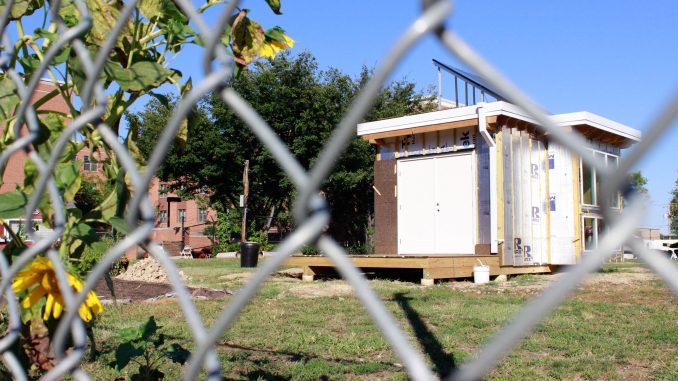
In January 2015, a team of students competed in an architectural design contest for the future building of a sustainable tiny house. The tiny house, located in the Temple Community Garden (TCG) at the corner of Diamond and Carlisle streets, was a dream for the future, but now that future is here.
Kathleen Grady, the director of sustainability, said representatives from the Fox School of Business, College of Engineering, Tyler School of Art, the geography and urban studies department and the former School of Environmental Design formed an interdisciplinary committee to discuss a collaborative sustainability project in 2014.
Now, after two years of designing, planning and construction, the tiny house is nearly complete.
Blake Larson, a senior engineering major who worked with the engineering team, is interested in energy and energy conservation. While working in the Office of Sustainability, he has seen the tiny house bring many different people together.
“This building is a result of Temple University coming together from different disciplines and working towards a common goal,” Larson said.
Seven teams of five students competed to design the tiny house in a one-day event. The teams were given an objective to design a sustainable tiny house that would be judged by a jury. The winning team was awarded $1,000 and the second-place team got $500.
Alex Burchman, an electrical engineering major and member of the winning design team, is interested in the future of electrical energy and technology within the tiny house.
The tiny house was designed and built to be as environmentally friendly as the budget allowed and includes a green roof, a composting toilet and all sustainable building materials, like cork siding. Grady said the house is “entirely off the grid” because it is powered by solar panels.
“This is important because it advances the adoption of technology like solar panels and solar thermal into the local community,” Burchman said.
Once the house is complete, Grady said, it will be used for sustainability demonstrations, TCG meetings and demonstrations about locally grown food and will serve as a model for future affordable housing.
“If we just had it for [demonstrations for classes], it would kind of be a waste of space,” Grady said. The tiny house will serve as a meeting place for the community to learn about growing their own food, and employees of The Rad Dish Co-Op Cafe will give lessons on cooking with fresh produce.
“People have for decades been disconnected from fresh food and have just been eating processed food, so now when they grow an eggplant, no one knows what to do with [it],” she added. “We’re going to be doing demos on ‘How do you make this yummy?’ and getting people excited about preparing the vegetables they’re growing.”
The tiny house will also serve as a miniature greenhouse, so TCG will be able to begin growing vegetables earlier in the year.
The tiny house was under construction this summer by a construction class taught by Robert Shuman, an architecture professor. The team hopes to have it ready by early November.
“Very few of [Shuman’s students] had construction experience, so it’s a really great way to get them to think about the complexity of an architecture project and really to see what that reality looks like, and meanwhile the engineering students are making sure that all the systems are working,” Grady said.
Grady said a major goal of the tiny house project is to “shift the paradigm of how design work is completed” and involve multiple disciplines in the design and construction process.
“[This project] addresses public health issues, it addresses environmental issues, it addresses design issues and policy issues,” she said.
“Instead of having everybody working in their silos, if you bring everyone together you may be able to find a design that will achieve your sustainability goals, but at a reduced price,” she added.
“This building is a result of Temple University coming together from different disciplines and working towards a common goal,” Larson said.
Brittany Fulwider and Erin Moran can be reached at features@temple-news.edu.


Be the first to comment